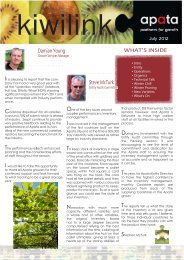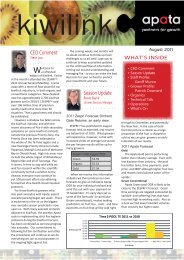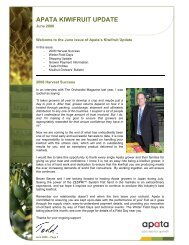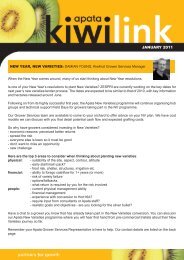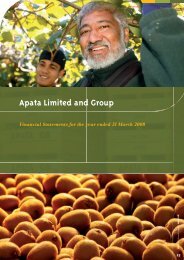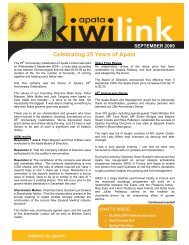Create successful ePaper yourself
Turn your PDF publications into a flip-book with our unique Google optimized e-Paper software.
MOVING FORWARD WITH BUSINESS PARTNERSHIPS : Steve Low<br />
From left: Steve Low <strong>Apata</strong> CEO with John Carroll,<br />
director of Primor Produce Limited.<br />
<strong>28</strong> <strong>JUNE</strong> <strong>2011</strong><br />
Our successful 23-year relationship with Auckland-based produce marketers, Primor Produce Limited, just<br />
got stronger. On behalf of the Board of Directors I am pleased to announce <strong>Apata</strong> has purchased a 33<br />
percent share in Primor.<br />
We now have complete integration between post-harvest and marketing services. Many years ago our<br />
focus was on kiwifruit and our avocado business developed because the avocado peak-season occurs<br />
during our kiwifruit off-season. But it was our strong personal connection and inherently successful<br />
business partnership with Primor that really helped get us to the next level and become the size we are<br />
today.<br />
<strong>Apata</strong>’s decision to invest was not made overnight but was carefully negotiated over a period of six months.<br />
Strategically, we focus on providing a premium service to growers. So, over the past few years we ensured<br />
continual reevaluation and improvement to our harvesting logistics, and post harvest packing supply chain,<br />
while investing a sizeable amount of capital into those systems. But what became increasingly apparent<br />
and imperative during the last few seasons is that <strong>Apata</strong> needed to have a stronger strategic focus to<br />
encourage more growth.<br />
Our principles in considering how to foster and grow<br />
our avocado business were based on taking the<br />
years of success we’ve experienced and figuring<br />
out what we needed to do from an orchard, postharvest<br />
perspective to ensure optimisation of our<br />
services. The way forward for <strong>Apata</strong> was to invest<br />
in Primor. The company is an extremely efficient<br />
and high performing market business and has a well<br />
developed network into key Australian and Asian<br />
markets, in addition to the New Zealand domestic<br />
market. It means we can share even more of our<br />
successes with each other.<br />
For us, this means we will gain a deeper<br />
understanding of marketing strategies while<br />
becoming more visible. While we are the largest<br />
post-harvest avocado provider, we will not lose sight<br />
of what is really important, which is you, our grower.<br />
We will work closely with you to target certain<br />
markets. In essence, we will send your fruit at just<br />
the right time and to the best location, resulting in<br />
optimum returns. As far as professional marketers<br />
go, you will already know that Primor are very<br />
connected with growers unlike some marketers that<br />
sit in an office and work from their desk. I expect<br />
this to be a very natural progression for everyone.
John Carroll, Primor director has said he was impressed even as a young man in the 1980s, by the way<br />
<strong>Apata</strong> operated with high work ethics, integrity and professionalism. <strong>Apata</strong> were not the first to hold<br />
discussions with Primor regarding a financial partnership over the years. John shared with me that<br />
the fact Primor agreed to sell 33 percent of their shares, says a lot about how much they value doing<br />
business with <strong>Apata</strong> and is a huge credit to us.<br />
No one had to do this. Neither company is under financial stress. This is a simple evolution of what has<br />
already been a successful, positive and simple relationship.<br />
The New Zealand avocado industry needs allegiances and stronger, seamless supply chains to help<br />
increase export. Primor handle over 30 percent of the New Zealand national avocado crop which is<br />
mostly packed at <strong>Apata</strong>. Primor’s focus has been on the Australian market where they do substantial<br />
business with Coles Supermarkets, and the beauty of supplying to Australia is that it is a high value<br />
market on a world scale, right on New Zealand’s doorstep.<br />
Because Australia is close, the fruit doesn’t have to travel far, and our natural supply window into that<br />
market is right in the peak of their consumption time, which is their summer. And just like other parts<br />
of the world, the Australian avocado market has continued to grow. It’s been a real success story<br />
particularly in the past 10 to 15 years and there are always new consumers coming into the market and<br />
existing consumers are finding more and more ways to use avocados. New Zealand can be a significant<br />
international player in our own right.<br />
<strong>Apata</strong> buying into Primor gives both parties not only a degree of security, but it achieves the same<br />
for customers and growers. Together, <strong>Apata</strong> and Primor are positioned to deliver the best product,<br />
information and supply possible to a wide range of world markets.<br />
<strong>Apata</strong> and Oropi Management Services (OMS)<br />
Our Primor acquisition closely follows another recent announcement whereby <strong>Apata</strong> purchased 50<br />
percent of Tauranga-based orchard management services company, Oropi Management Services<br />
(OMS).<br />
In bringing the strengths of <strong>Apata</strong> and OMS together, we will be able to offer you, our growers, more<br />
options. In fact, you are now able to access a wrap-around service. OMS is experienced in orchard<br />
leasing and management of organic and conventional kiwifruit, which complements our post harvest<br />
services.<br />
OMS directors are Doug Voss, also former Zespri chairman, and Bruce MacDiamid. OMS is BioGrocertified<br />
for organic kiwifruit, but they offer total management services for both organic and conventional<br />
kiwifruit.<br />
The high level of expertise between our companies means we can put our heads together and look after<br />
everything a grower needs. For example, OMS can provide turn-key orchard management for growers,<br />
or they can modify a plan for a grower who might want to do the work themselves. <strong>Apata</strong> can become<br />
part of OMS management plan to include picking, packing, storing, and exporting grower fruit. OMS also<br />
offers a comprehensive spray programme including fertiliser application.<br />
Steve Low<br />
<strong>Apata</strong> Chief Executive Officer
ON ORCHARD RESULTS: Bevan Bayne<br />
After each harvest season there is a sea of data which is created and shared. What I would like to share<br />
below is a couple of points that growers can use as a comparison to their own crop, or view as an item of<br />
interest relative to the industry.<br />
Rejects rates<br />
A supportive growing season and significant thinning and grooming in green delivered the lowest reject<br />
rates in the last four years (and possibly ever in Gold). Whanganui fruit was particularly good with reject<br />
rates under 10 precent across several hundred thousand trays. Unfortunately, Whangarei district had high<br />
reject rates resulting from a growing season which produced increased levels of water stain, proximity<br />
mark, and in some cases sooty mould levels similar to Bay of Plenty in 2010.<br />
AVE SIZE REJ RATE <strong>2011</strong> REJ RATE 2010<br />
HWCK 33.79 15.5% 16.7%<br />
GKCK 32.54 15.9% 21.3%<br />
GKOB 34.68 20.3% 24%<br />
HWOB 35.55 15.1% 18.1%<br />
GL 31.49 19.3%<br />
GA <strong>28</strong>.45 12.3%<br />
Yield<br />
<strong>Apata</strong> growers mirrored the industry in producing record volumes this season providing <strong>Apata</strong> with its<br />
largest submit volume ever. Over 9 million trays were submitted by <strong>Apata</strong> and its Satellite sites with this<br />
increase coming 50/50 from new grower supply and increased yield.<br />
tarys per hectare<br />
13,000<br />
12,000<br />
11,000<br />
10,000<br />
9,000<br />
8,000<br />
7,000<br />
6,000<br />
Industry Figures supplied by ZESPRI Limited<br />
Seasonal Production per hectare<br />
2007 2008 2009 2010 <strong>2011</strong><br />
HAYWARD - CLASS 1 ONLY 7,731 8,175 7,985 7,675 8,584<br />
GOLD - CLASS 1 ONLY 10,358 11,262 10,748 9,395 12,400
Taste<br />
As has been written many times <strong>Apata</strong> gold growers produced fruit similar in taste band to the industry.<br />
What is interesting is that the <strong>Apata</strong> green conventional supply is different than industry with significantly<br />
more Y Band fruit. While this brought some challenge with more layered packaging in the pack house, it is<br />
hoped this will support a positive shipping programme.<br />
100%<br />
90%<br />
80%<br />
70%<br />
60%<br />
50%<br />
40%<br />
30%<br />
20%<br />
10%<br />
0%<br />
GK1CK Taste Split<br />
Industry APATA<br />
TECHNICAL UPDATE : Wade Hunkin<br />
Industry Figures supplied by ZESPRI Limited<br />
Taste Split Comparison<br />
Winter Pruning<br />
The summer of 2010/11 is unlikely to have been as positive as the previous one, with respect to flower bud<br />
initiation, and with a warm start to winter budbreak is likely to be poor. Most vines were cropped heavily<br />
this harvest so there is an increased risk of low overall flower numbers in spring.<br />
One response might be to increase overall bud numbers, but generally that will lead to problems later in<br />
summer, when with Psa on the horizon we should be looking to minimise the number of wounds we create.<br />
The key messages to come out of our recent round of field days are pretty straightforward and well known<br />
to us all but remain worth repeating:<br />
• Select strong wood that has been grown early and spent the summer out in the light<br />
• Fill all the canopy area and pay attention to the area close to the leader<br />
• Watch the bud spacing. Crowded areas will become a problem later<br />
• Supervision and review of the job is a critical component<br />
• Seal all saw cuts as a minimum and all large lopper cuts as a well if PSA risk is high<br />
Y<br />
T<br />
R<br />
M<br />
100%<br />
Scale was not a major issue for conventional growers this season; the widespread use of Movento has had<br />
a positive effect. However, the need for continued action on crowns remains. As part of the pruning regime<br />
look to target one large crown on each leader as these provide a perfect reservoir of over wintering scale.<br />
90%<br />
80%<br />
70%<br />
60%<br />
50%<br />
40%<br />
30%<br />
20%<br />
10%<br />
0%<br />
HW1CK Taste Split<br />
Industry APATA<br />
Y<br />
T<br />
M
Winter Chill<br />
We are already experiencing a warm wet winter with May and June being approximately two degrees warmer<br />
than the same period last year. If this continues as predicted then:<br />
• Leaves will be slow to drop<br />
• Ground will remain wet and waterlogged for some soil types so avoid mulching when soils are<br />
waterlogged<br />
• Pruning will get late<br />
• Budbreak will be delayed<br />
Graphs of accumulated winter chill compared with previous years are normally published fortnightly during<br />
July and August at http://www.hortnet.co.nz/news/<strong>2011</strong>/chilling.htm so the comparisons can be made year on<br />
year. With average temperatures to date having been considerably higher than even last year we can expect<br />
budbreak to be further delayed but by how much is difficult to predict - the simple models are likely to break<br />
down at the extremes.<br />
We will be holding a workshop in the first week of August to look at Hicane timing and approaches should the<br />
weather become problematic.<br />
Crop protection<br />
We have been encouraged by the overall response to the call to apply protective copper sprays before Psa<br />
symptoms appear. The majority of growers have looked to hasten the drop of leaves with copper sulphate,<br />
have applied at least one protective copper since and are intending to make further applications around<br />
pruning. Watch the timing around Hicane and allow four weeks between the last copper application and<br />
Hicane.<br />
The information you will all have received from KVH sets out the Rolls Royce programme. Your response<br />
needs to be tailored to your level of risk so if your situation is high risk, as those in the Te Puke are<br />
contending with, then you should be making every practical effort to fulfill that programme. Those more<br />
remote could consider a reduced program but the leaf fall and spring components would be a minimum. We<br />
can assist with tailoring your program if you need help.<br />
Outside Te Puke Te Puke<br />
Cleanup spray Cleanup spray<br />
Copper after picking<br />
Copper Sulphate to speed leaf drop Copper Sulphate to speed leaf drop<br />
Copper at leaf fall Copper at leaffall x 2<br />
Copper prior to pruning<br />
Seal larger wounds Seal all wounds<br />
Copper after pruning Copper after pruning<br />
KVH expect to have recommendations for the spring period available shortly.<br />
Getting complete spray coverage is a key component in a copper protection programme. If you applied<br />
copper sulphate to drop leaves, how successful were you? In many cases we have observed that upper<br />
leaves and leaves on row ends or outside rows have remained, suggesting coverage has been far from<br />
complete. Have a close look at your sprayer setup and check spray is going where you need it. Investing in<br />
some water sensitive paper and putting it in the canopy is a great way to check on how successful you (or<br />
your contractor) is at getting the 100% coverage you need.<br />
Other On Orchard reminders<br />
• Mulch leaves to speed breakdown<br />
• Winter pruning<br />
• Lichen cleanup spays (lime sulphur or Graphic) can be applied after the leaves drop<br />
• Organise base fertiliser requirements<br />
• Carry out structure repairs<br />
• Tighten wires to lift the low spots
OPERATIONAL UPDATE : Chris Kearns<br />
Fruit Quality<br />
Packing at all sites finished mid-June with record volumes being submitted. The overall grading table<br />
reject rates were very good particularly in Gold in the Bay of Plenty.<br />
Focus has now switched to inventory management of our fruit in store, with Gold due to be in store for four<br />
weeks longer than ever before, and large volumes of green to ship during the course of the year. This is<br />
going to be a huge challenge given the late maturity year we have experienced.<br />
Already we are seeing worrying signs in both Green and Gold, particularly in regards to soft fruit and other<br />
storage defects . CA packing starts at <strong>Apata</strong> Turntable Hill Road site this week, with a view to processing<br />
fruit as quickly as possible in conjunction with our conventional inventory.<br />
<strong>Apata</strong> Inventory at Week 25<br />
Submit Shipped % Shipped Fruit Loss<br />
Hayward 4,436,647 1,361,160 30.7 0.06<br />
Hayward Organic 1,912,132 697,504 36.5 0.01<br />
Gold 2,463,943 1,370,216 55.6 0.7<br />
PSA SIGNAGE<br />
We have secured a large stock of orchard Psa signs for <strong>Apata</strong> growers.<br />
We will be distributing these as requried during our call cycles. You can also visit <strong>Apata</strong> Reception to<br />
collect one.
<strong>Apata</strong> Contact Details<br />
<strong>Apata</strong> Turntable Hill Road, RD2 Katikati Phone: 07 552 0911 Fax: 07 552 0666<br />
Pyes Pa 83 Pyes Pa Road, RD3 Tauranga Phone: 07 543 1211 Fax: 07 543 0096<br />
Northland 37 Southend Avenue, Whangarei Phone: 09 430 8003 Fax: 09 430 8006<br />
Kiwifruit Services Contact Details<br />
reception@apata.co.nz www.apata.co.nz<br />
Kiwifruit Grower Services Manager GM Grower Services<br />
Damian Young 027 500 8586 Bevan Bayne 027 511 6666<br />
Grower Services Grower Services Coordinator<br />
Neale Cameron 027 582 6364 Trina Hawkins 07 552 0512<br />
Organic Category Manager Harvest Manager<br />
Andrew Wood 027 475 1323 Piers Zajac-Wiggett 027 426 5548<br />
Whangarei Growers Services Manager Communications Manager 07 552 0535<br />
Louise Hailes 027 200 9954 Vivette Reid 021 102 6401<br />
Technical Advice Grower Payments<br />
Wade Hunkin 027 481 9905 Dinah Rutherford 07 552 0504<br />
DISCLAIMER: The information contained in this publication is intended to be of a general nature and should be treated as a guide only. <strong>Apata</strong><br />
makes no warranty or representation as to the accuracy or completeness of the information, photographs or other published material in this<br />
publication. In this publication, published material authored by a person other than <strong>Apata</strong> reflects the view of the author and not the view of<br />
<strong>Apata</strong>. <strong>Apata</strong> shall not be liable to any person for loss, injury or damages arising from any person’s reliance on the published material.



